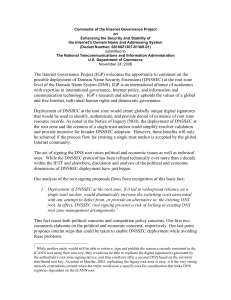Supporting a Healthy and Resilient Internet
advertisement
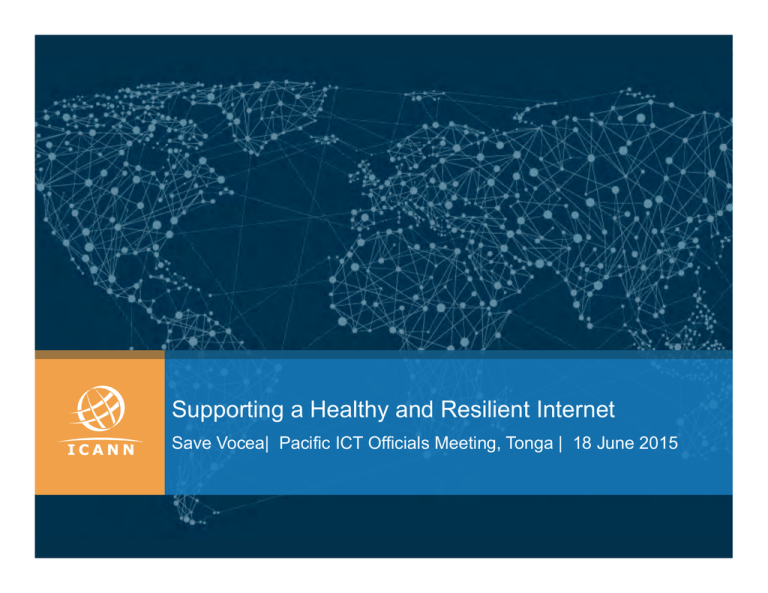
Supporting a Healthy and Resilient Internet Save Vocea| Pacific ICT Officials Meeting, Tonga | 18 June 2015 Internet Corporation for Assigned Names and Numbers (ICANN) 1 Dedicated to keeping Internet Secure, Stable and Interoperable 2 Formed in 1998 as a not-for-profit publicbenefit cooperation 3 Follows multistakeholder model | 2 Functions that ICANN Coordinates + Domain Name System (DNS) + Internet Protocol (IP) Address and Autonomous System Number (AS) Allocation + Protocol-Parameter Registry + Root Server Systems + Generic Top-Level Domain Names (gTLD) system management + Country-code Top-Level Domain Name (ccTLD) + Time Zone Database Management | 3 Unique Identifiers and SSR Need + SSR – Security, Stability and Resiliency + Misuse of and attacks against the DNS and global networks challenge overall unique identifier security – Affect the broad range of users, individuals, businesses, civil society, governments etc. + Security in the context of the Internet's unique identifiers should be addressed through a healthy Internet ecosystem. – an Internet that is sustainable or healthy, stable and resilient | 4 Security, Stability, & Resiliency (SSR) A key pillar of ICANN The Internet – our “Network of Networks” Threat Awareness and Response Gov Law Enforcem ent Network Operators ICANN Trust-based Collaboration Capability Building Domain Operators CERTs Regional Internet Registries Identifier SSR Analytics | 5 Root Servers to benefit Internet Stability and Resiliency + Root server nodes keep Internet traffic local and resolve queries faster + Make it easier to isolate attacks + Reduce congestion on international bandwidth + Redundancy and load balancing with multiple instances + ICANN is the L-Root Operator | 7 L-Root presence + Geographical diversity via Anycast + Around 160 dedicated servers + Presence on every continent + On normal basis 15 ~ 25 kbps + Approx. 2 billion DNS queries a day + We are supporting root server deployment in countries + Contact ICANN staff in the region | 8 L-Root anycast server locations | 9 Making the DNS Secure + A computer sends a question to a DNS server, like “where is www.example.org?” + It receives an answer and assumes that it is correct. + There are multiple ways that traffic on the Internet can be intercepted and modified to give a false answer. | 10 How can bad guys attack the DNS? A>ack Descrip?on Cache Poisoning Dupe a resolver into adding false DNS records to its cache (example: basic cache poisoning) Indirec@on aAack Malware can also poison a client computer's /etc/hosts file (example: DNSChanger) Distributed Denial of service (DDoS) aAack A resource deple@on aAack where 1000s of bots send DNS queries to a target NS DDoS amplifica@on (reflec@on) aAack 1000s of bots issue queries that evoke a very large response message, they all "spoof" the address of a targeted name server,and the targeted NS is flooded with very large DNS response messages requested by the compromised computers Exploita@on aAacks A bad guy discovers a soPware flaw that causes DNS server soPware to fail or behave in an unintended way Redirec@on (wildcarding, DNS response rewri@ng) Instead of a Name Error (NXDOMAIN), a name server or resolver returns a response it chooses | 11 ICANN strongly supports DNSSEC + Cyber security is becoming a greater concern to enterprises, government, and end users. DNSSEC is a key tool and differentiator. + DNSSEC is the biggest security upgrade to Internet infrastructure in over 20 years. It is a platform for new security applications (for those that see the opportunity). + DNSSEC infrastructure deployment has been brisk but requires expertise. Call for ccTLD registry and industry to implement DNSSEC | 12 How about Registrations? Importance of WHOIS from a Security point of view + whois.icann.org + Registration Data Directory Service - Database containing records of information + Verification of records - Sponsoring Registrar - Domain Name Servers - Domain Status - Creation/Expiry Dates - Point of Contacts - DNSSEC Data | 13 IPv6 and Security! ! + ICANN supports IPv6 + Mobile Internet, IoT, Smart Nations etc. + Partner to promote awareness + Capacity building with community + Be aware + When you are running IPv6 the device is accessible via IPv6 + Interface, Routing filters and firewall rules already present in IPv4 must be replicated for IPv6 + Failure to protect the device after enabling IPv6 means that it is wide open to abuse through IPv6 transport (Even though the IPv4 security is in place) | 14 SSR Capability Building Capability Building DNS Training • Security • DNS Operations • Abuse/Misuse Knowledge Transfer • Europol • Interpol • RIRs • Training and Outreach – Security, operations, and DNS/DNSSEC deployment training • for TLD registry operators • Network Operators / ISPs • Enterprises, Corporates etc. – Information gathering to identify Internet Identifier Systems abuse/misuse and Investigation Techniques • Law Enforcement Agencies • CERTs • Internet Investigators etc. | 15 Engage with ICANN Thank You and Questions Email: <save.vocea@icann.org> ICANN Website: icann.org twitter.com/icann gplus.to/icann facebook.com/icannorg weibo.com/ICANNorg linkedin.com/company/icann flickr.com/photos/icann youtube.com/user/icannnews slideshare.net/icannpresentations | 16
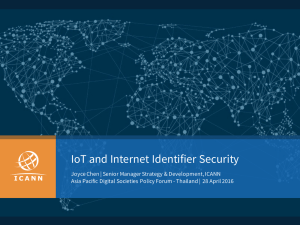
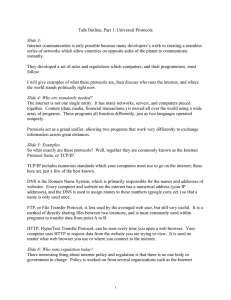
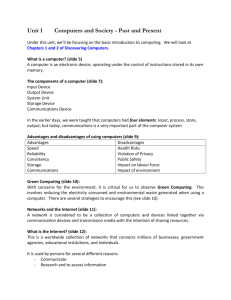
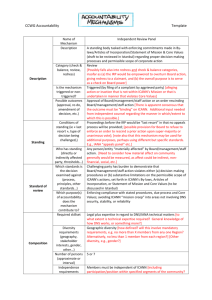
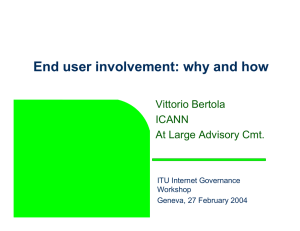
![Understanding Internet Focus Institutions [Session 6]](http://s2.studylib.net/store/data/013498335_1-a7543c01106339877633153c13852746-300x300.png)
